
flashinfer
FlashInfer: Kernel Library for LLM Serving
Stars: 3808
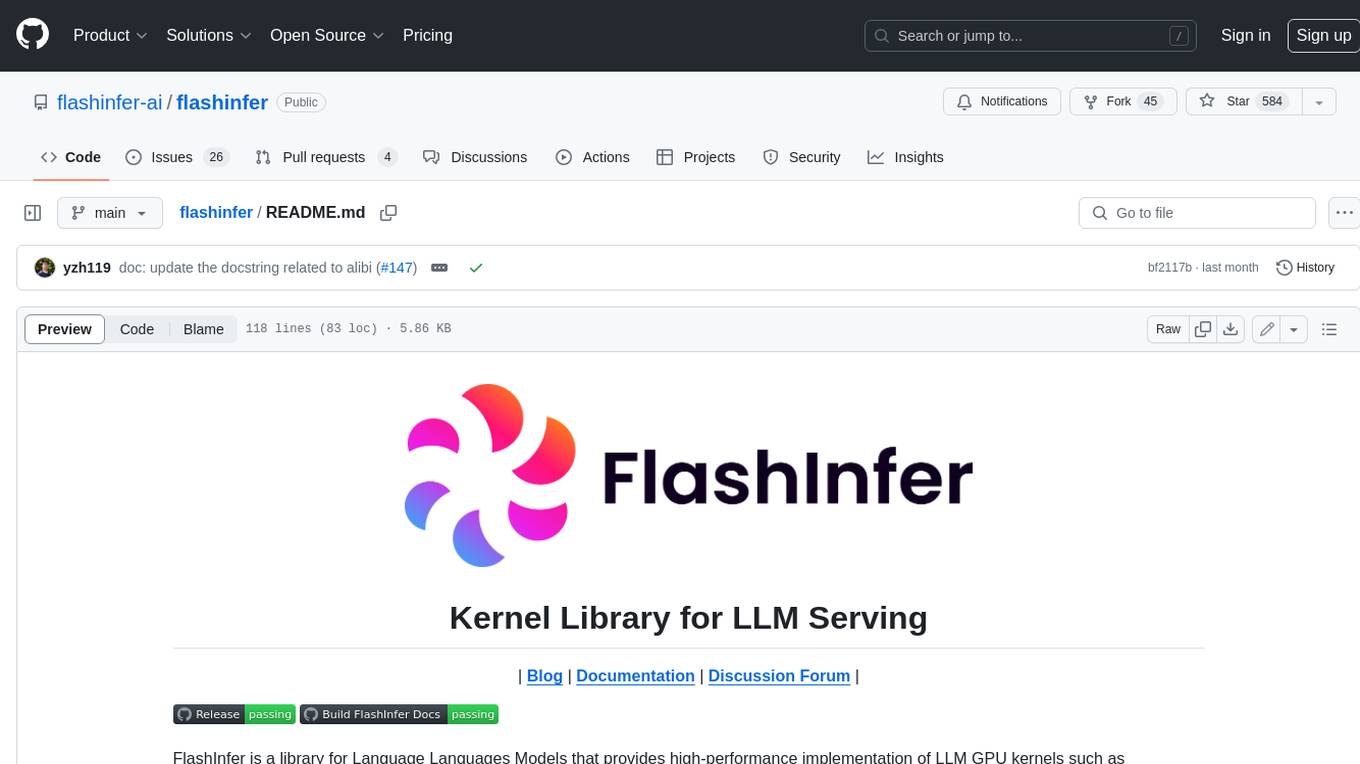
FlashInfer is a library for Language Languages Models that provides high-performance implementation of LLM GPU kernels such as FlashAttention, PageAttention and LoRA. FlashInfer focus on LLM serving and inference, and delivers state-the-art performance across diverse scenarios.
README:
| Blog | Documentation | Slack | Discussion Forum |
FlashInfer is a library and kernel generator for Large Language Models that provides high-performance implementation of LLM GPU kernels such as FlashAttention, SparseAttention, PageAttention, Sampling, and more. FlashInfer focuses on LLM serving and inference, and delivers state-of-the-art performance across diverse scenarios.
Check our v0.2 release blog for new features!
The core features of FlashInfer include:
- Efficient Sparse/Dense Attention Kernels: Efficient single/batch attention for sparse(paged)/dense KV-storage on CUDA Cores and Tensor Cores (both FA2 & FA3) templates. The vector-sparse attention can achieve 90% of the bandwidth of dense kernels with same problem size.
-
Load-Balanced Scheduling: FlashInfer decouples
plan/runstage of attention computation where we schedule the computation of variable-length inputs inplanstage to alleviate load-imbalance issue. - Memory Efficiency: FlashInfer offers Cascade Attention for hierarchical KV-Cache, and implements Head-Query fusion for accelerating Grouped-Query Attention, and efficient kernels for low-precision attention and fused-RoPE attention for compressed KV-Cache.
- Customizable Attention: Bring your own attention variants through JIT-compilation.
- CUDAGraph and torch.compile Compatibility: FlashInfer kernels can be captured by CUDAGraphs and torch.compile for low-latency inference.
- Efficient LLM-specific Operators: High-Performance fused kernel for Top-P, Top-K/Min-P sampling without the need to sorting.
FlashInfer supports PyTorch, TVM and C++ (header-only) APIs, and can be easily integrated into existing projects.
- [Mar 10, 2025] Blog Post Sorting-Free GPU Kernels for LLM Sampling, which explains the design of sampling kernels in FlashInfer.
- [Mar 1, 2025] Checkout flashinfer's intra-kernel profiler for visualizing the timeline of each threadblock in GPU kernels.
- [Dec 16, 2024] Blog Post FlashInfer 0.2 - Efficient and Customizable Kernels for LLM Inference Serving
- [Sept 2024] We've launched a Slack workspace for Flashinfer users and developers. Join us for timely support, discussions, updates and knowledge sharing!
- [Jan 31, 2024] Blog Post Cascade Inference: Memory-Efficient Shared Prefix Batch Decoding
- [Jan 31, 2024] Blog Post Accelerating Self-Attentions for LLM Serving with FlashInfer
Using our PyTorch API is the easiest way to get started:
FlashInfer is available as a Python package for Linux on PyPI. You can install it with the following command:
pip install flashinfer-pythonAlternatively, build FlashInfer from source:
git clone https://github.com/flashinfer-ai/flashinfer.git --recursive
cd flashinfer
python -m pip install -v .
# for development & contribution, install in editable mode
python -m pip install --no-build-isolation -e . -vTo pre-compile essential kernels ahead-of-time (AOT), run the following command:
# Set target CUDA architectures
export FLASHINFER_CUDA_ARCH_LIST="7.5 8.0 8.9 9.0a 10.0a"
# Build AOT kernels. Will produce AOT kernels in aot-ops/
python -m flashinfer.aot
# Build AOT wheel
python -m build --no-isolation --wheel
# Install AOT wheel
python -m pip install dist/flashinfer_*.whlFor more details, refer to the Install from Source documentation.
Below is a minimal example of using FlashInfer's single-request decode/append/prefill attention kernels:
import torch
import flashinfer
kv_len = 2048
num_kv_heads = 32
head_dim = 128
k = torch.randn(kv_len, num_kv_heads, head_dim).half().to(0)
v = torch.randn(kv_len, num_kv_heads, head_dim).half().to(0)
# decode attention
num_qo_heads = 32
q = torch.randn(num_qo_heads, head_dim).half().to(0)
o = flashinfer.single_decode_with_kv_cache(q, k, v) # decode attention without RoPE on-the-fly
o_rope_on_the_fly = flashinfer.single_decode_with_kv_cache(q, k, v, pos_encoding_mode="ROPE_LLAMA") # decode with LLaMA style RoPE on-the-fly
# append attention
append_qo_len = 128
q = torch.randn(append_qo_len, num_qo_heads, head_dim).half().to(0) # append attention, the last 128 tokens in the KV-Cache are the new tokens
o = flashinfer.single_prefill_with_kv_cache(q, k, v, causal=True) # append attention without RoPE on-the-fly, apply causal mask
o_rope_on_the_fly = flashinfer.single_prefill_with_kv_cache(q, k, v, causal=True, pos_encoding_mode="ROPE_LLAMA") # append attention with LLaMA style RoPE on-the-fly, apply causal mask
# prefill attention
qo_len = 2048
q = torch.randn(qo_len, num_qo_heads, head_dim).half().to(0) # prefill attention
o = flashinfer.single_prefill_with_kv_cache(q, k, v, causal=False) # prefill attention without RoPE on-the-fly, do not apply causal maskCheck out documentation for usage of batch decode/append/prefill kernels and shared-prefix cascading kernels.
Starting from FlashInfer v0.2, users can customize their own attention variants with additional parameters. For more details, refer to our JIT examples.
FlashInfer also provides C++ API and TVM bindings, please refer to documentation for more details.
FlashInfer currently provides support for NVIDIA SM architectures 75 and higher and beta support for 103, 110, 120, and 121.
We are thrilled to share that FlashInfer is being adopted by many cutting-edge projects, including but not limited to:
FlashInfer is inspired by FlashAttention 1&2, vLLM, stream-K, cutlass and AITemplate projects.
If you find FlashInfer helpful in your project or research, please consider citing our paper:
@article{ye2025flashinfer,
title = {FlashInfer: Efficient and Customizable Attention Engine for LLM Inference Serving},
author = {
Ye, Zihao and
Chen, Lequn and
Lai, Ruihang and
Lin, Wuwei and
Zhang, Yineng and
Wang, Stephanie and
Chen, Tianqi and
Kasikci, Baris and
Grover, Vinod and
Krishnamurthy, Arvind and
Ceze, Luis
},
journal = {arXiv preprint arXiv:2501.01005},
year = {2025},
url = {https://arxiv.org/abs/2501.01005}
}For Tasks:
Click tags to check more tools for each tasksFor Jobs:
Alternative AI tools for flashinfer
Similar Open Source Tools

flashinfer
FlashInfer is a library for Language Languages Models that provides high-performance implementation of LLM GPU kernels such as FlashAttention, PageAttention and LoRA. FlashInfer focus on LLM serving and inference, and delivers state-the-art performance across diverse scenarios.
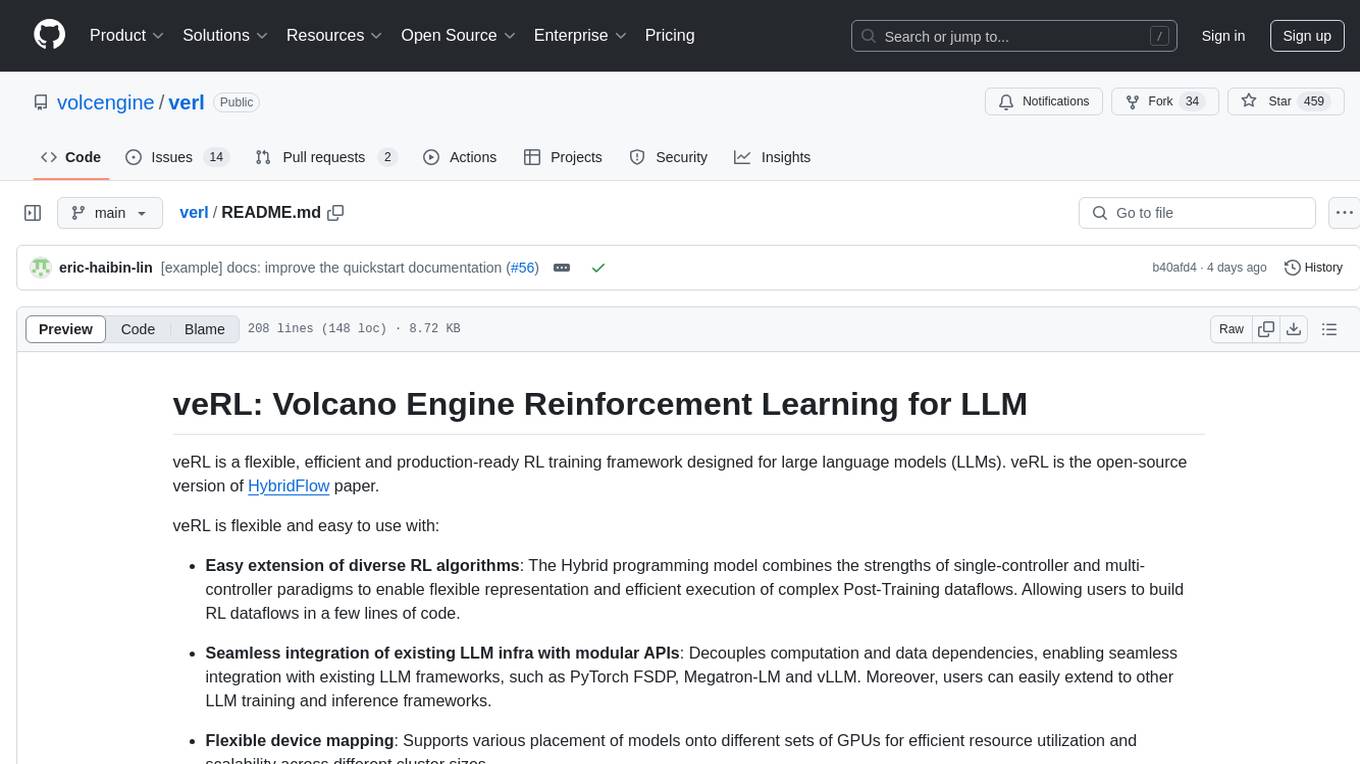
verl
veRL is a flexible and efficient reinforcement learning training framework designed for large language models (LLMs). It allows easy extension of diverse RL algorithms, seamless integration with existing LLM infrastructures, and flexible device mapping. The framework achieves state-of-the-art throughput and efficient actor model resharding with 3D-HybridEngine. It supports popular HuggingFace models and is suitable for users working with PyTorch FSDP, Megatron-LM, and vLLM backends.
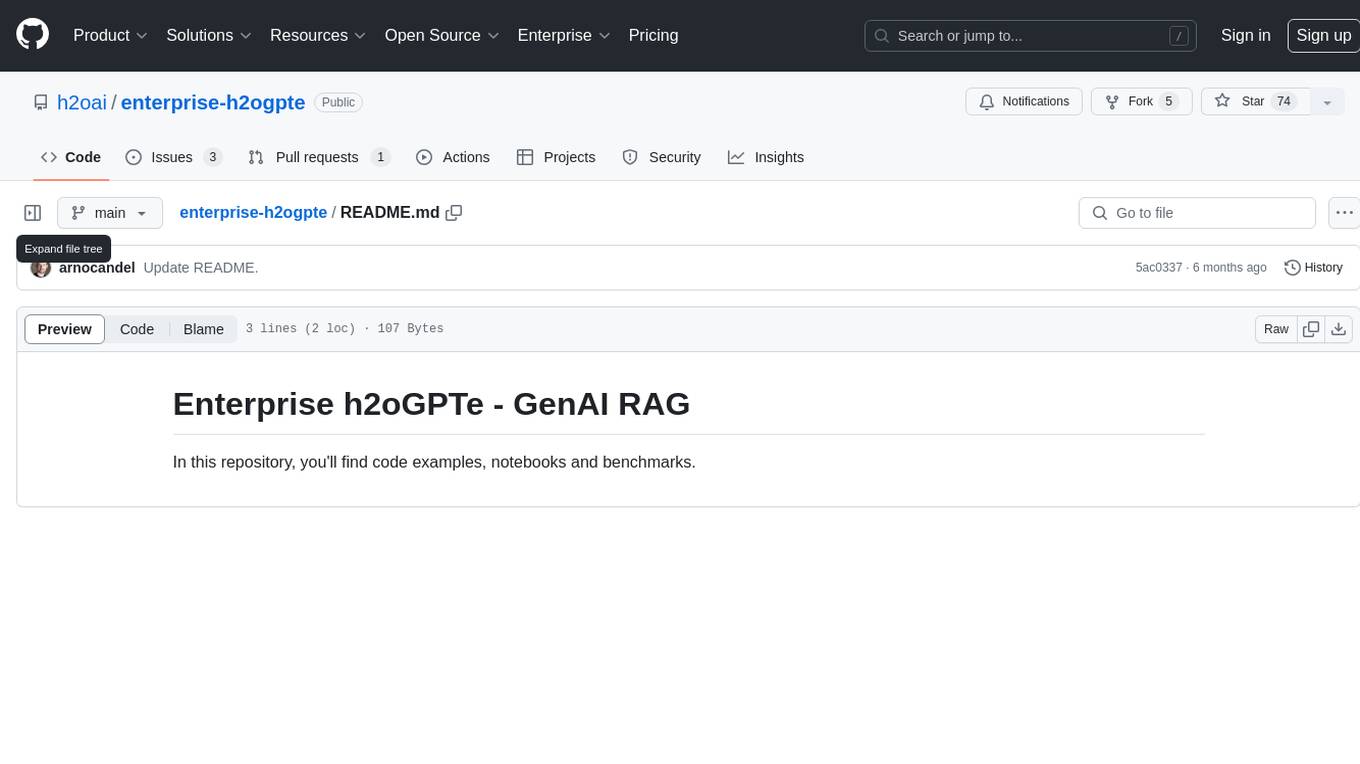
enterprise-h2ogpte
Enterprise h2oGPTe - GenAI RAG is a repository containing code examples, notebooks, and benchmarks for the enterprise version of h2oGPTe, a powerful AI tool for generating text based on the RAG (Retrieval-Augmented Generation) architecture. The repository provides resources for leveraging h2oGPTe in enterprise settings, including implementation guides, performance evaluations, and best practices. Users can explore various applications of h2oGPTe in natural language processing tasks, such as text generation, content creation, and conversational AI.
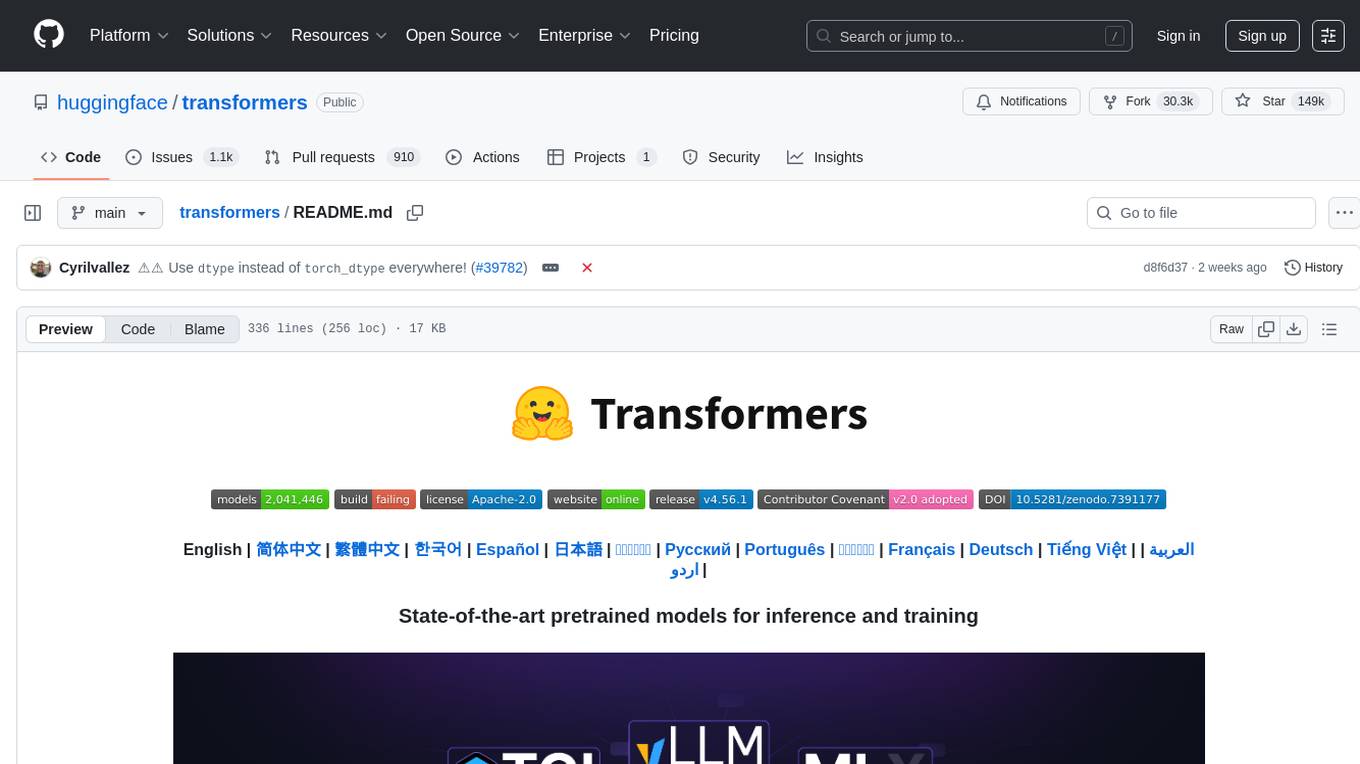
transformers
Transformers is a state-of-the-art pretrained models library that acts as the model-definition framework for machine learning models in text, computer vision, audio, video, and multimodal tasks. It centralizes model definition for compatibility across various training frameworks, inference engines, and modeling libraries. The library simplifies the usage of new models by providing simple, customizable, and efficient model definitions. With over 1M+ Transformers model checkpoints available, users can easily find and utilize models for their tasks.
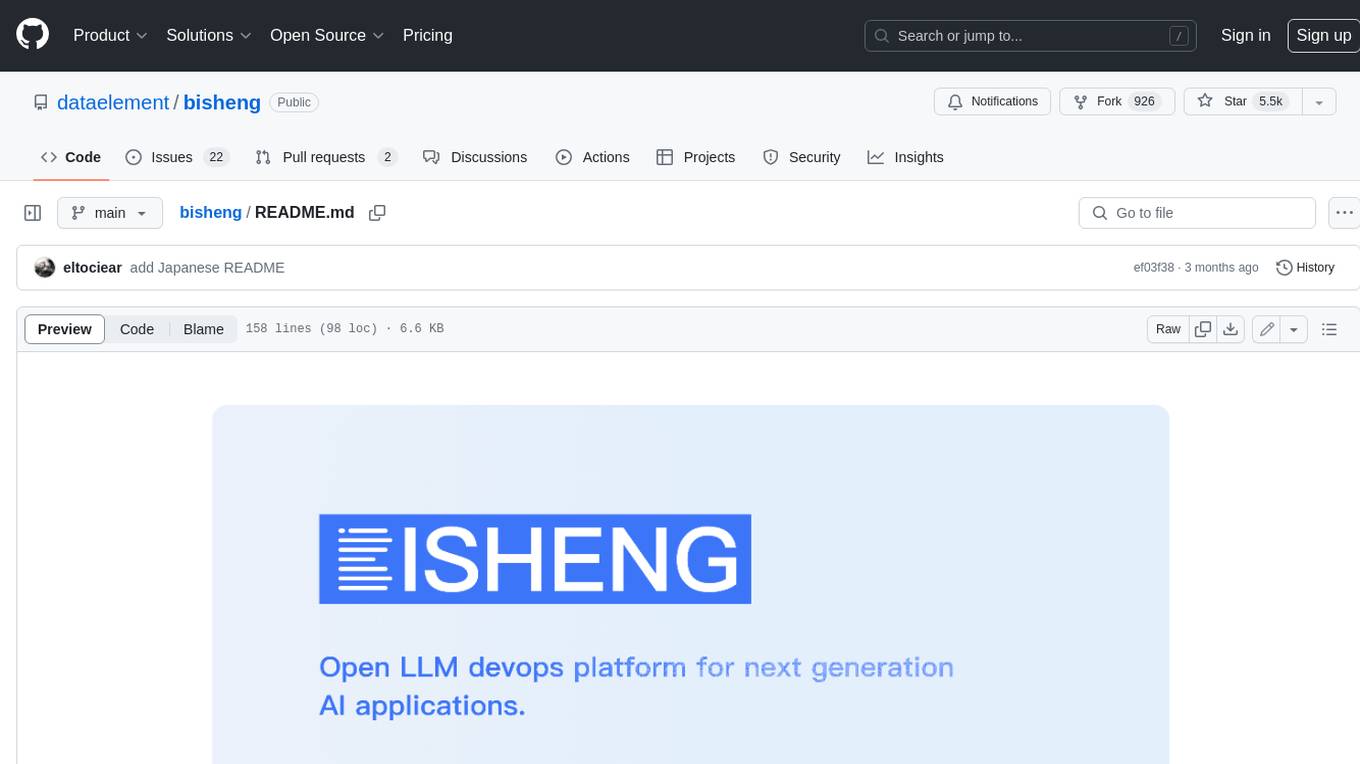
bisheng
Bisheng is a leading open-source **large model application development platform** that empowers and accelerates the development and deployment of large model applications, helping users enter the next generation of application development with the best possible experience.
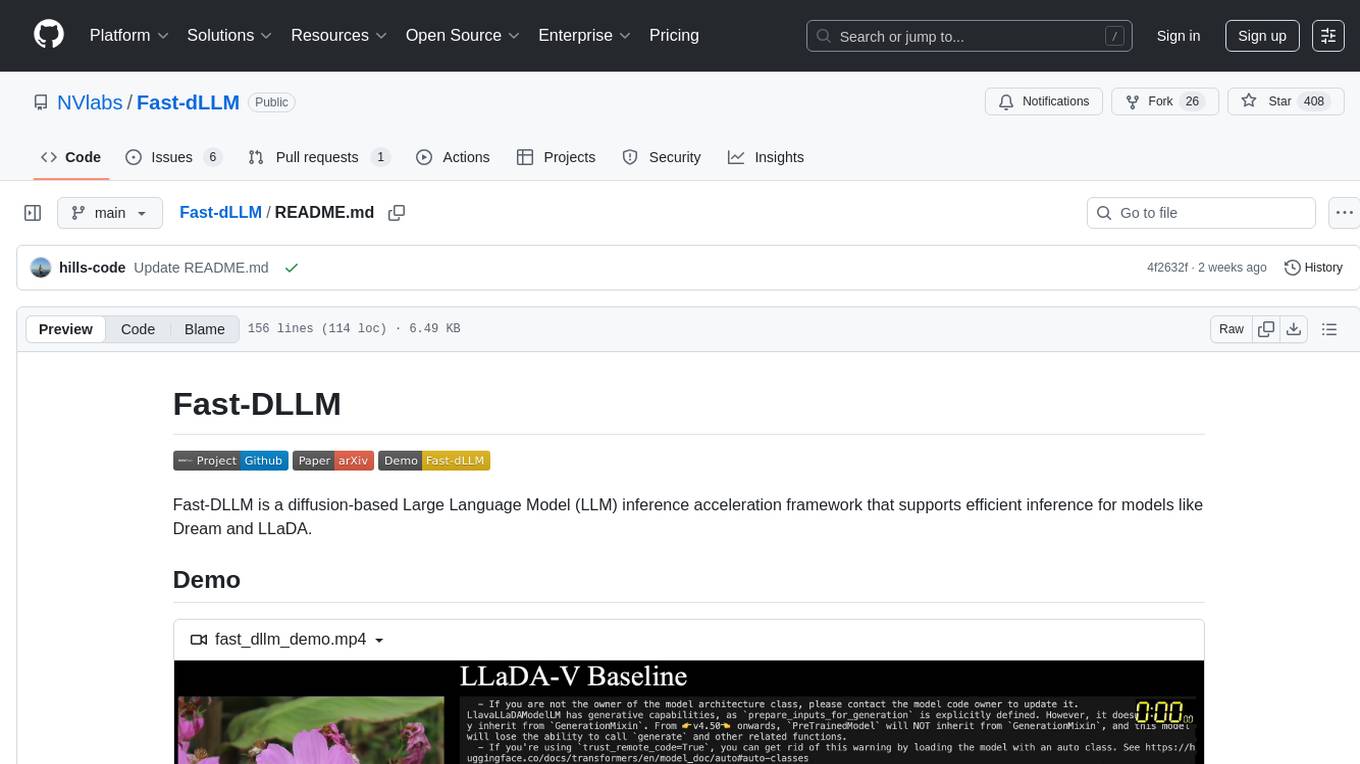
Fast-dLLM
Fast-DLLM is a diffusion-based Large Language Model (LLM) inference acceleration framework that supports efficient inference for models like Dream and LLaDA. It offers fast inference support, multiple optimization strategies, code generation, evaluation capabilities, and an interactive chat interface. Key features include Key-Value Cache for Block-Wise Decoding, Confidence-Aware Parallel Decoding, and overall performance improvements. The project structure includes directories for Dream and LLaDA model-related code, with installation and usage instructions provided for using the LLaDA and Dream models.
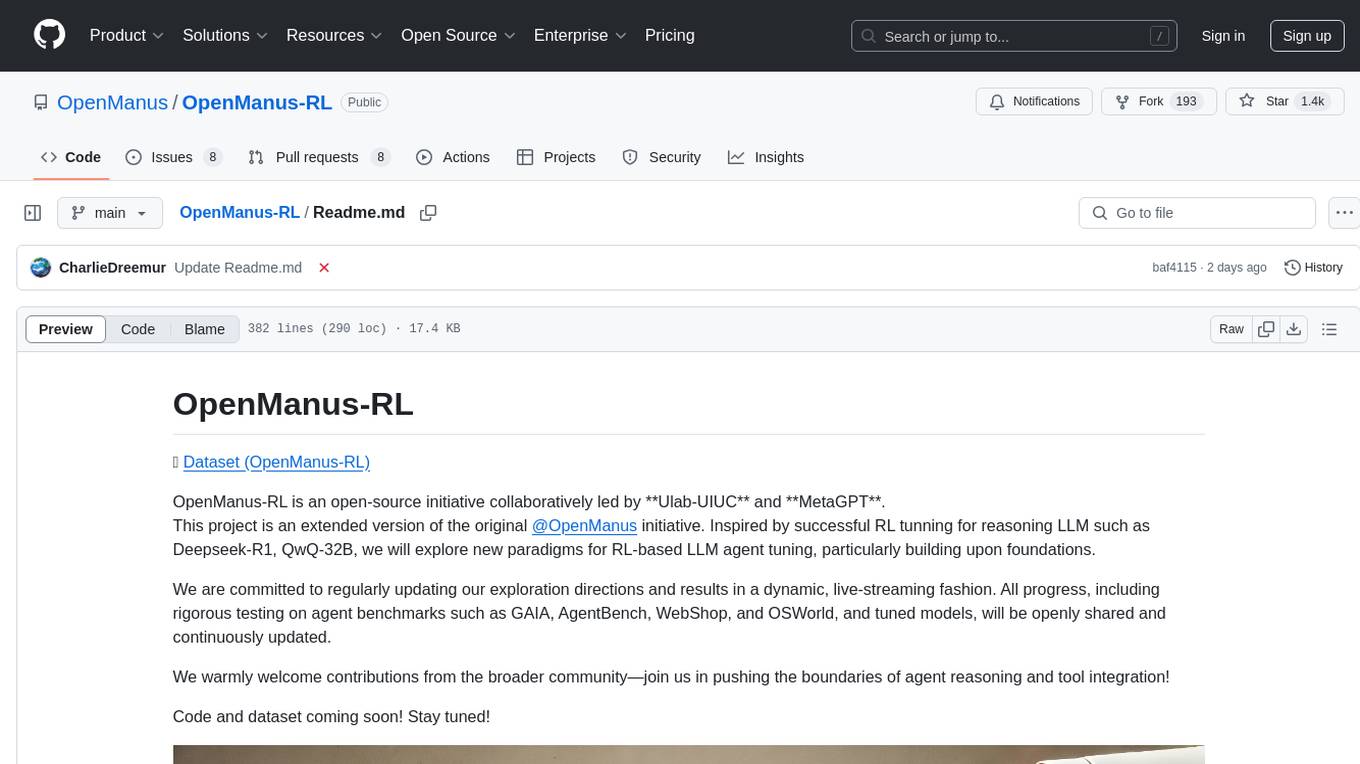
OpenManus-RL
OpenManus-RL is an open-source initiative focused on enhancing reasoning and decision-making capabilities of large language models (LLMs) through advanced reinforcement learning (RL)-based agent tuning. The project explores novel algorithmic structures, diverse reasoning paradigms, sophisticated reward strategies, and extensive benchmark environments. It aims to push the boundaries of agent reasoning and tool integration by integrating insights from leading RL tuning frameworks and continuously updating progress in a dynamic, live-streaming fashion.
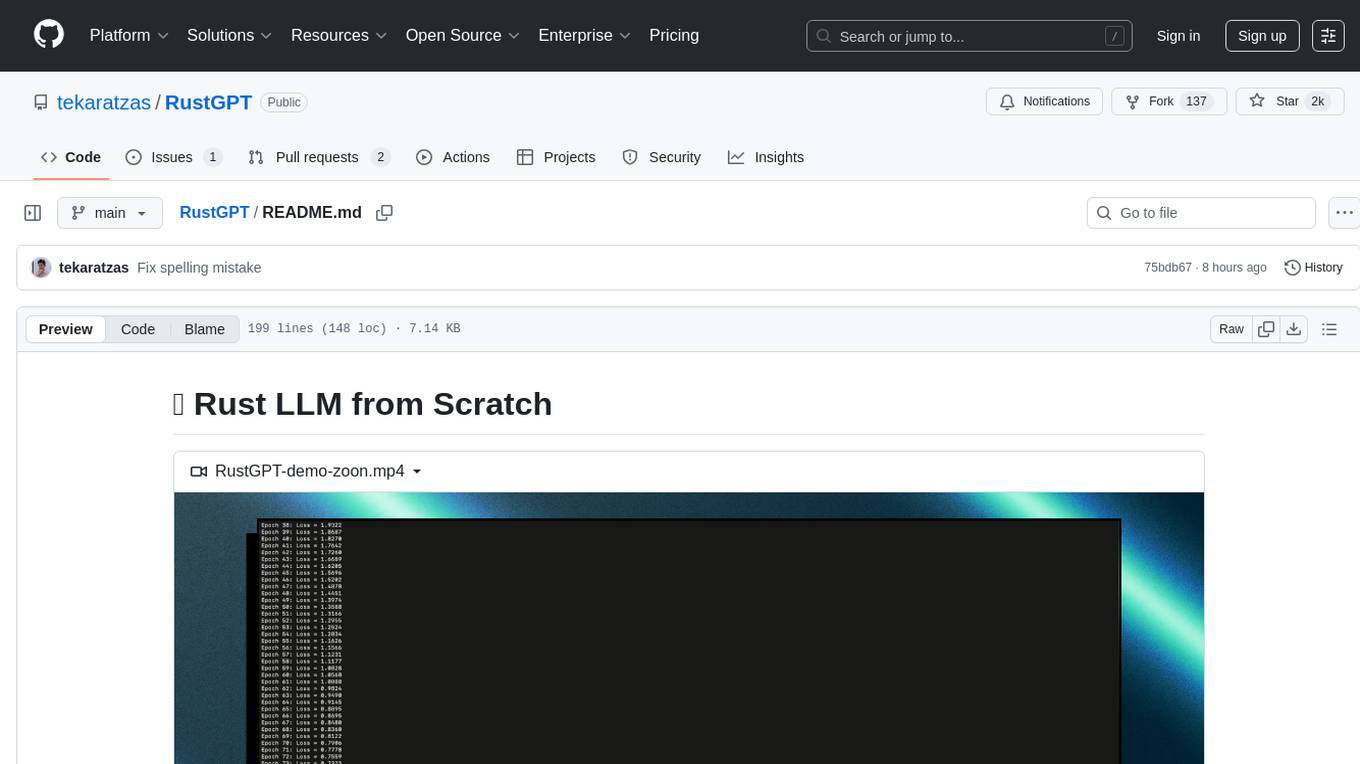
RustGPT
A complete Large Language Model implementation in pure Rust with no external ML frameworks. Demonstrates building a transformer-based language model from scratch, including pre-training, instruction tuning, interactive chat mode, full backpropagation, and modular architecture. Model learns basic world knowledge and conversational patterns. Features custom tokenization, greedy decoding, gradient clipping, modular layer system, and comprehensive test coverage. Ideal for understanding modern LLMs and key ML concepts. Dependencies include ndarray for matrix operations and rand for random number generation. Contributions welcome for model persistence, performance optimizations, better sampling, evaluation metrics, advanced architectures, training improvements, data handling, and model analysis. Follows standard Rust conventions and encourages contributions at beginner, intermediate, and advanced levels.
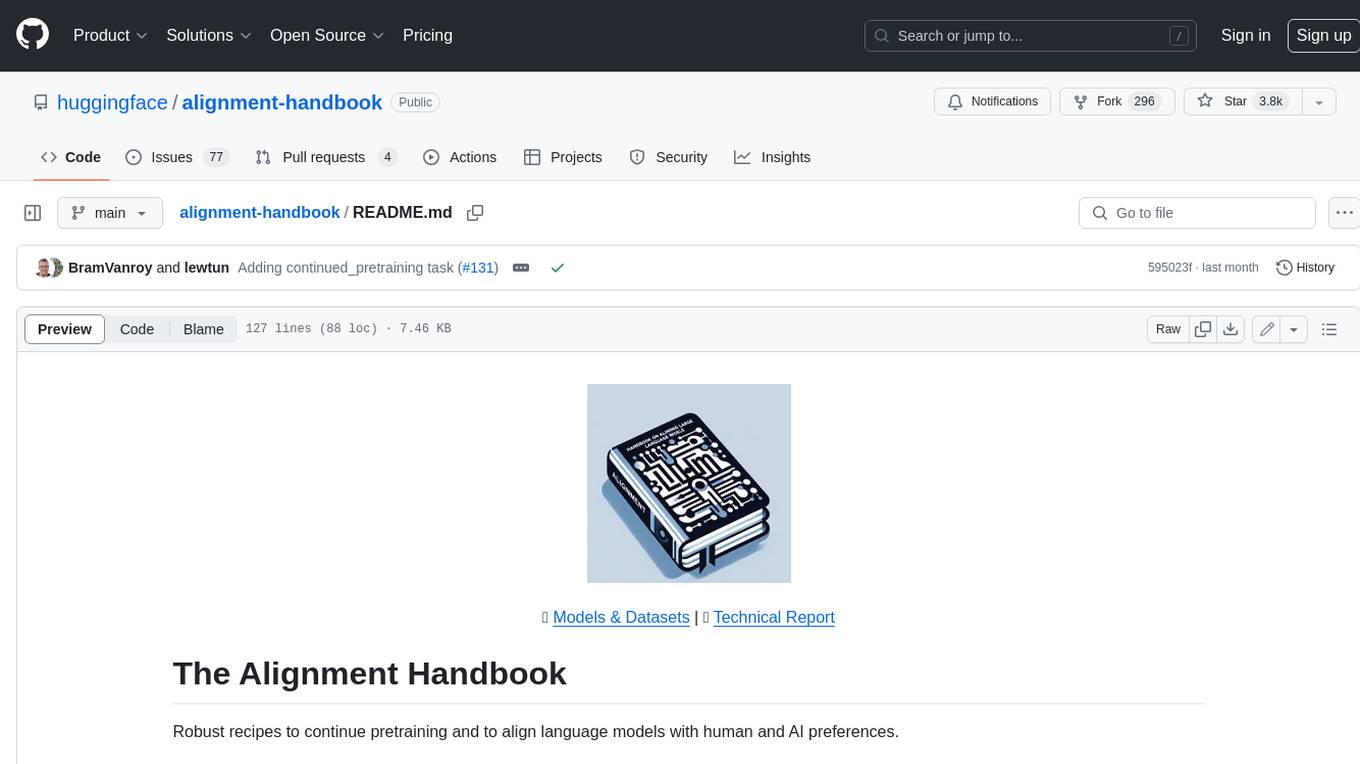
alignment-handbook
The Alignment Handbook provides robust training recipes for continuing pretraining and aligning language models with human and AI preferences. It includes techniques such as continued pretraining, supervised fine-tuning, reward modeling, rejection sampling, and direct preference optimization (DPO). The handbook aims to fill the gap in public resources on training these models, collecting data, and measuring metrics for optimal downstream performance.
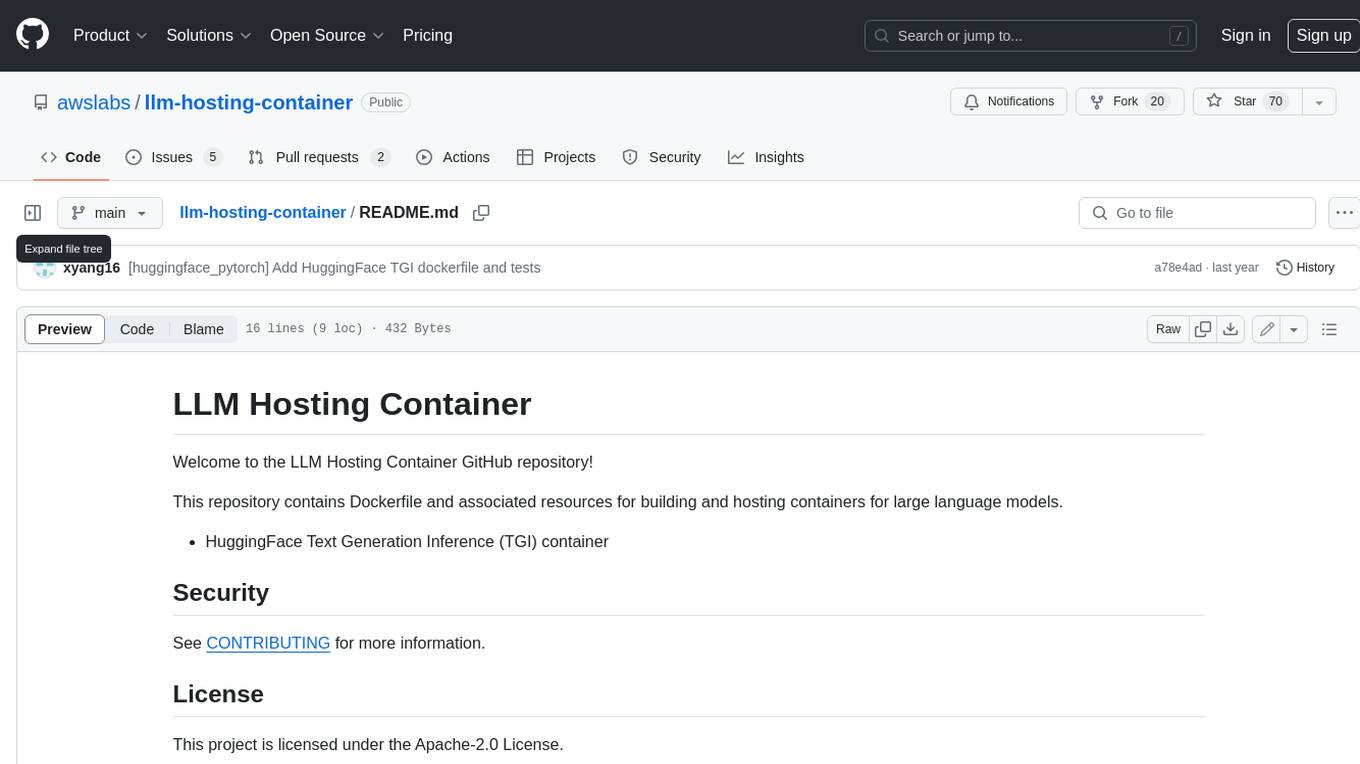
llm-hosting-container
The LLM Hosting Container repository provides Dockerfile and associated resources for building and hosting containers for large language models, specifically the HuggingFace Text Generation Inference (TGI) container. This tool allows users to easily deploy and manage large language models in a containerized environment, enabling efficient inference and deployment of language-based applications.
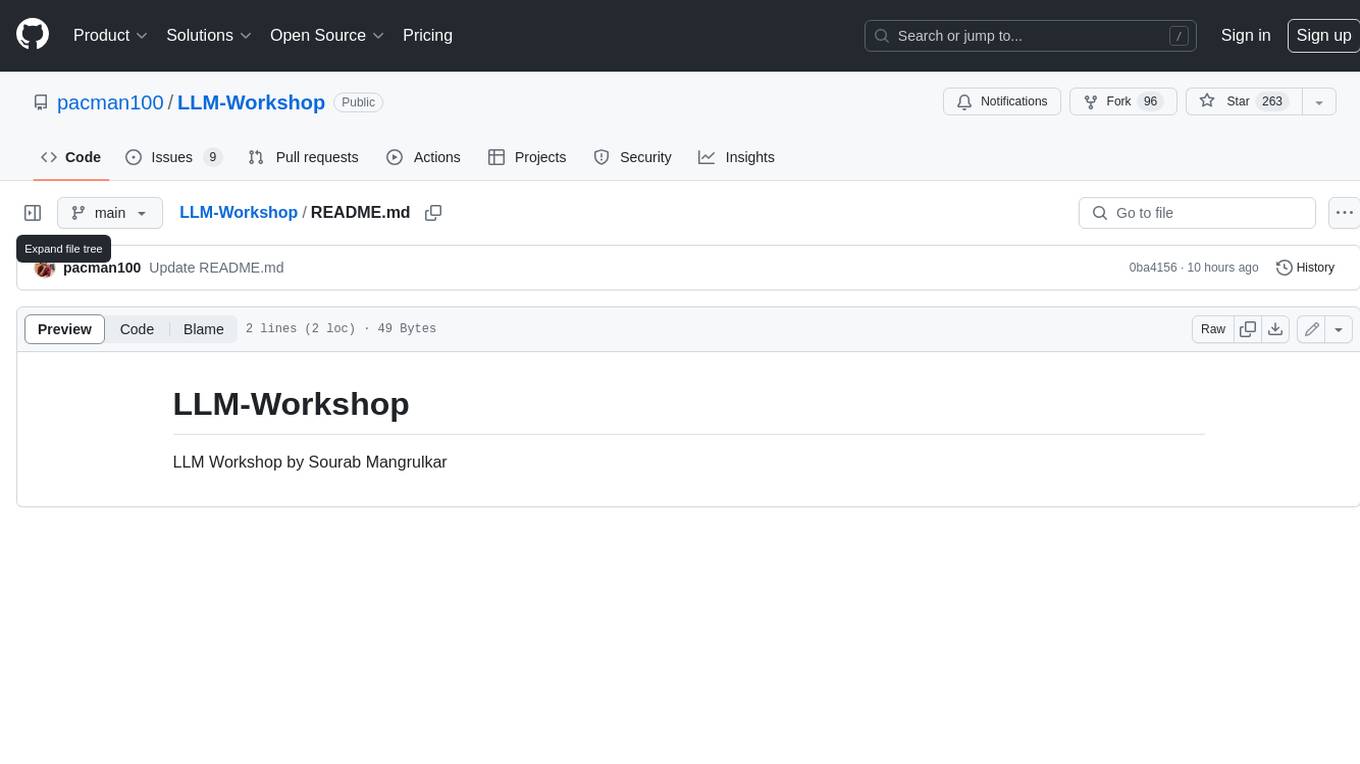
LLM-Workshop
This repository contains a collection of resources for learning about and using Large Language Models (LLMs). The resources include tutorials, code examples, and links to additional resources. LLMs are a type of artificial intelligence that can understand and generate human-like text. They have a wide range of potential applications, including natural language processing, machine translation, and chatbot development.
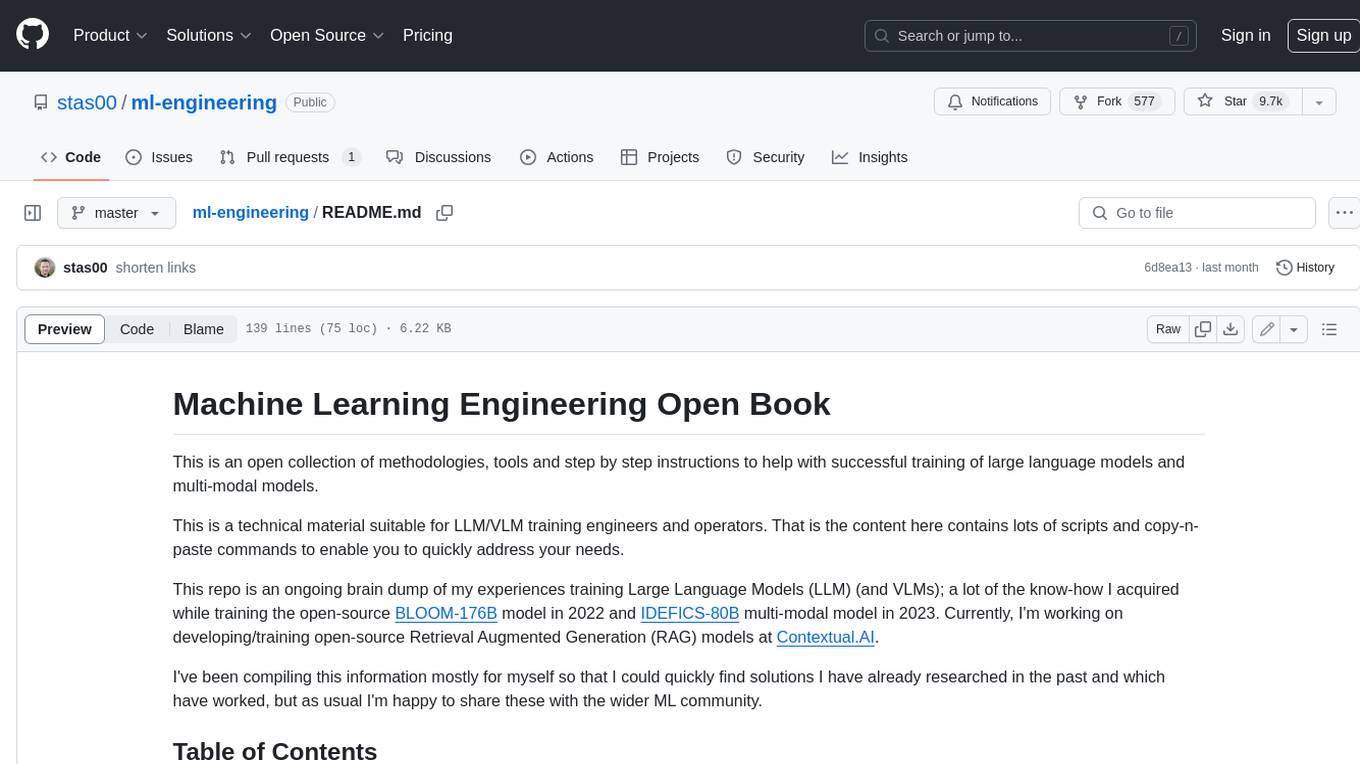
ml-engineering
This repository provides a comprehensive collection of methodologies, tools, and step-by-step instructions for successful training of large language models (LLMs) and multi-modal models. It is a technical resource suitable for LLM/VLM training engineers and operators, containing numerous scripts and copy-n-paste commands to facilitate quick problem-solving. The repository is an ongoing compilation of the author's experiences training BLOOM-176B and IDEFICS-80B models, and currently focuses on the development and training of Retrieval Augmented Generation (RAG) models at Contextual.AI. The content is organized into six parts: Insights, Hardware, Orchestration, Training, Development, and Miscellaneous. It includes key comparison tables for high-end accelerators and networks, as well as shortcuts to frequently needed tools and guides. The repository is open to contributions and discussions, and is licensed under Attribution-ShareAlike 4.0 International.
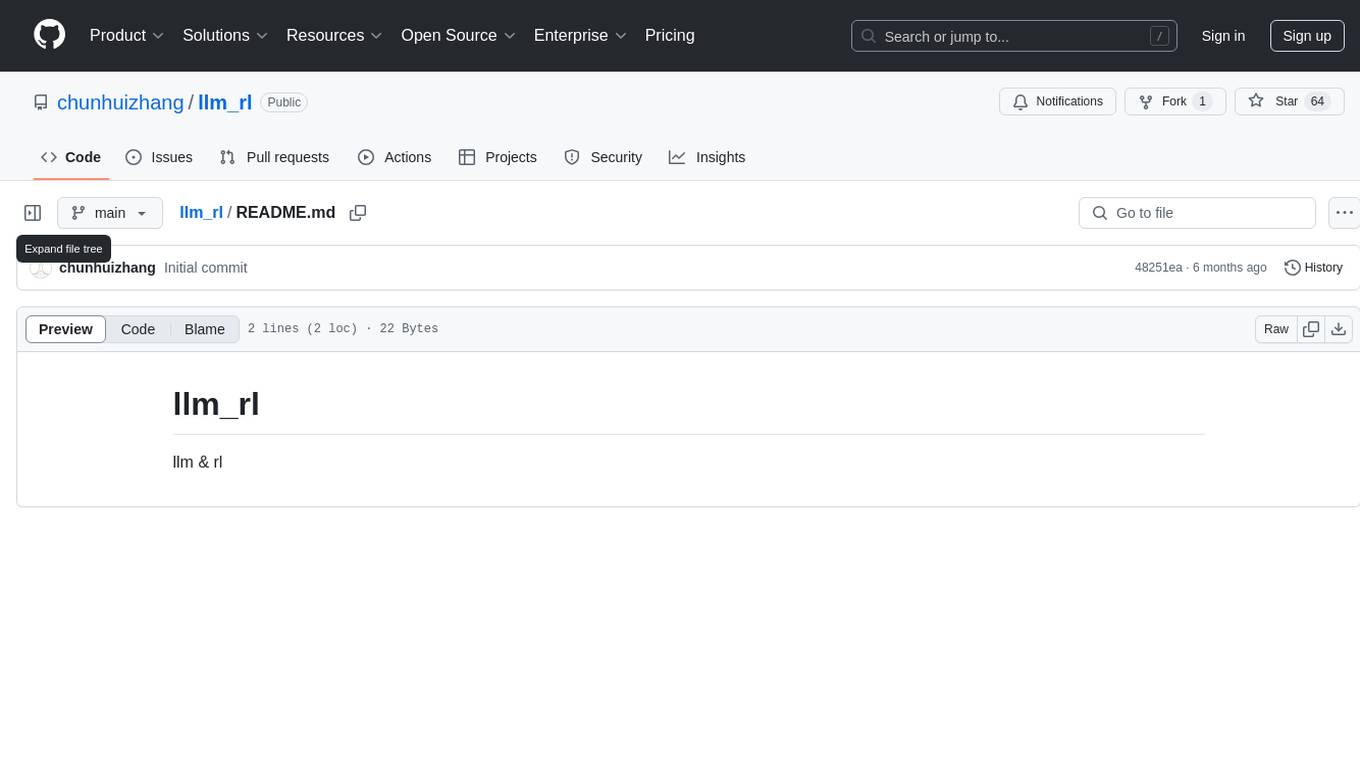
llm_rl
llm_rl is a repository that combines llm (language model) and rl (reinforcement learning) techniques. It likely focuses on using language models in reinforcement learning tasks, such as natural language understanding and generation. The repository may contain implementations of algorithms that leverage both llm and rl to improve performance in various tasks. Developers interested in exploring the intersection of language models and reinforcement learning may find this repository useful for research and experimentation.
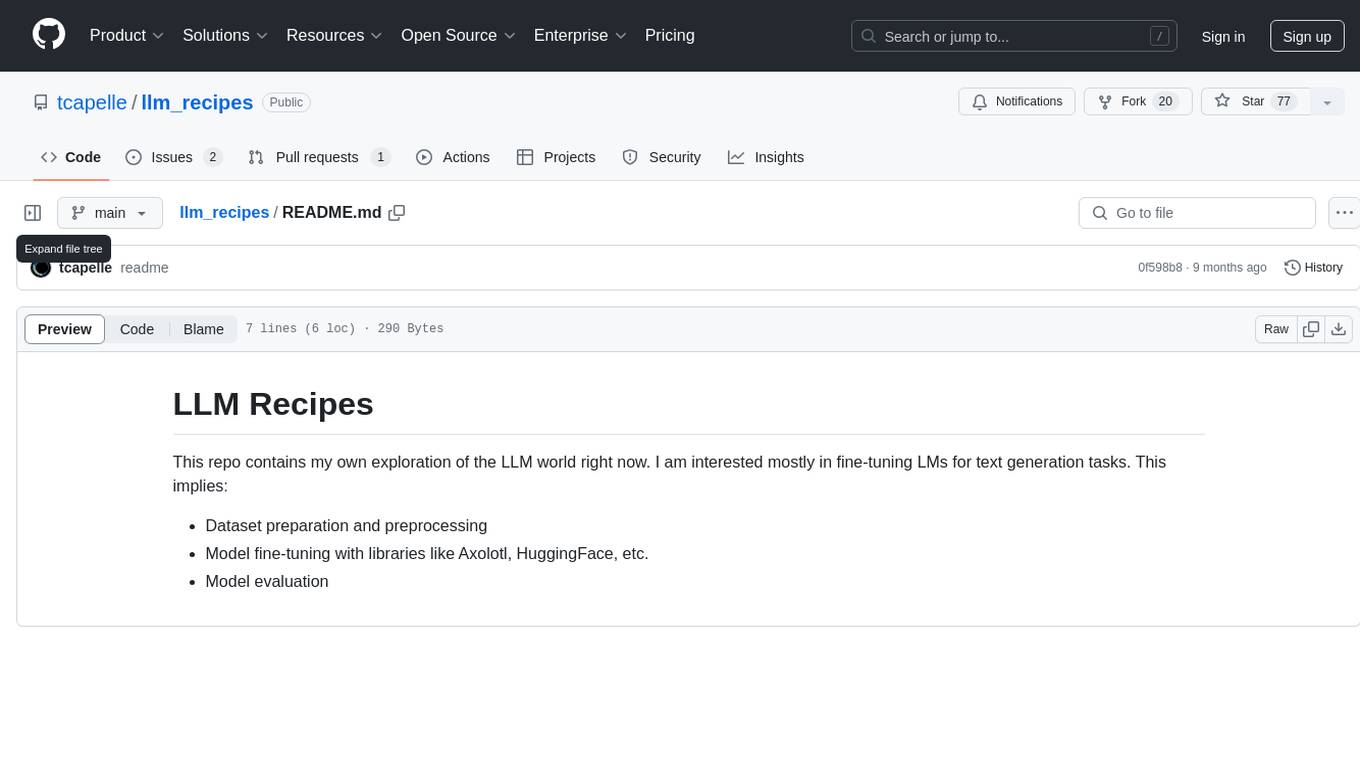
llm_recipes
This repository showcases the author's experiments with Large Language Models (LLMs) for text generation tasks. It includes dataset preparation, preprocessing, model fine-tuning using libraries such as Axolotl and HuggingFace, and model evaluation.
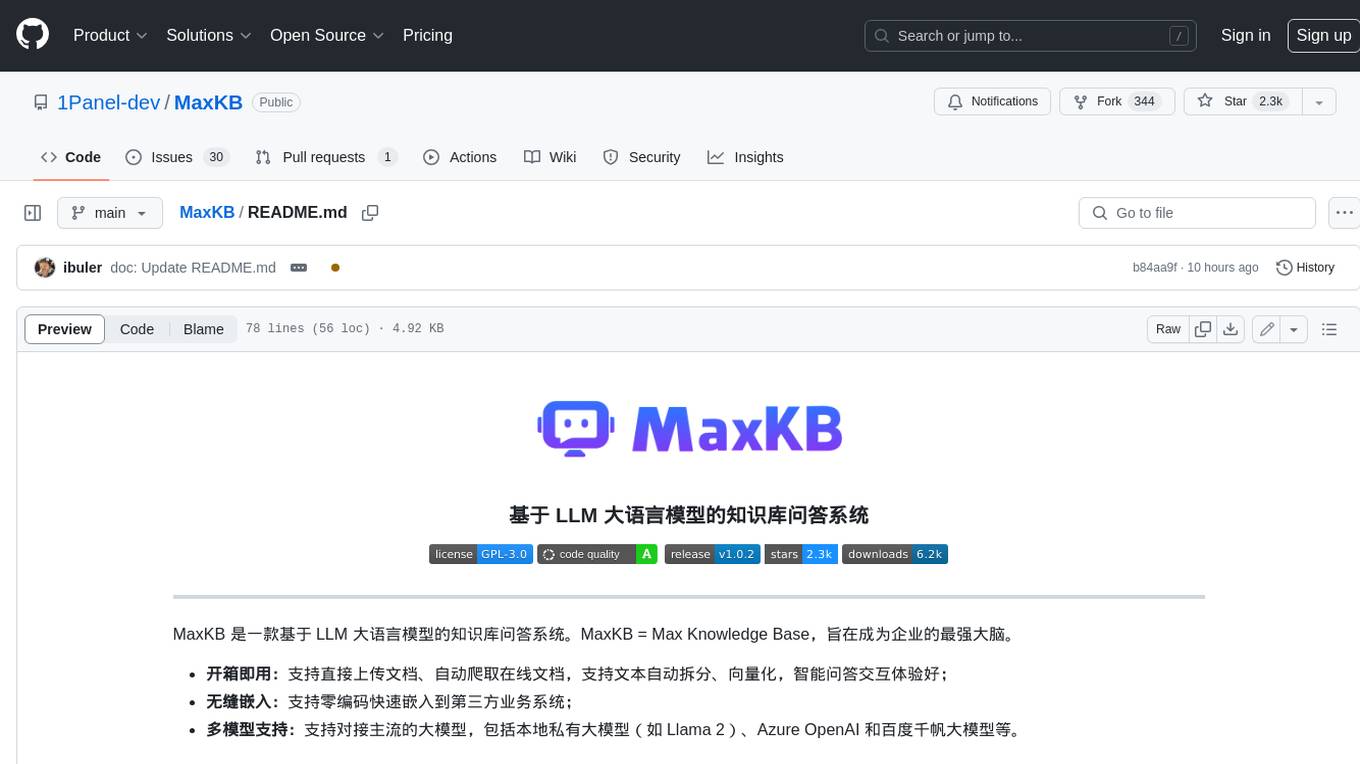
MaxKB
MaxKB is a knowledge base Q&A system based on the LLM large language model. MaxKB = Max Knowledge Base, which aims to become the most powerful brain of the enterprise.
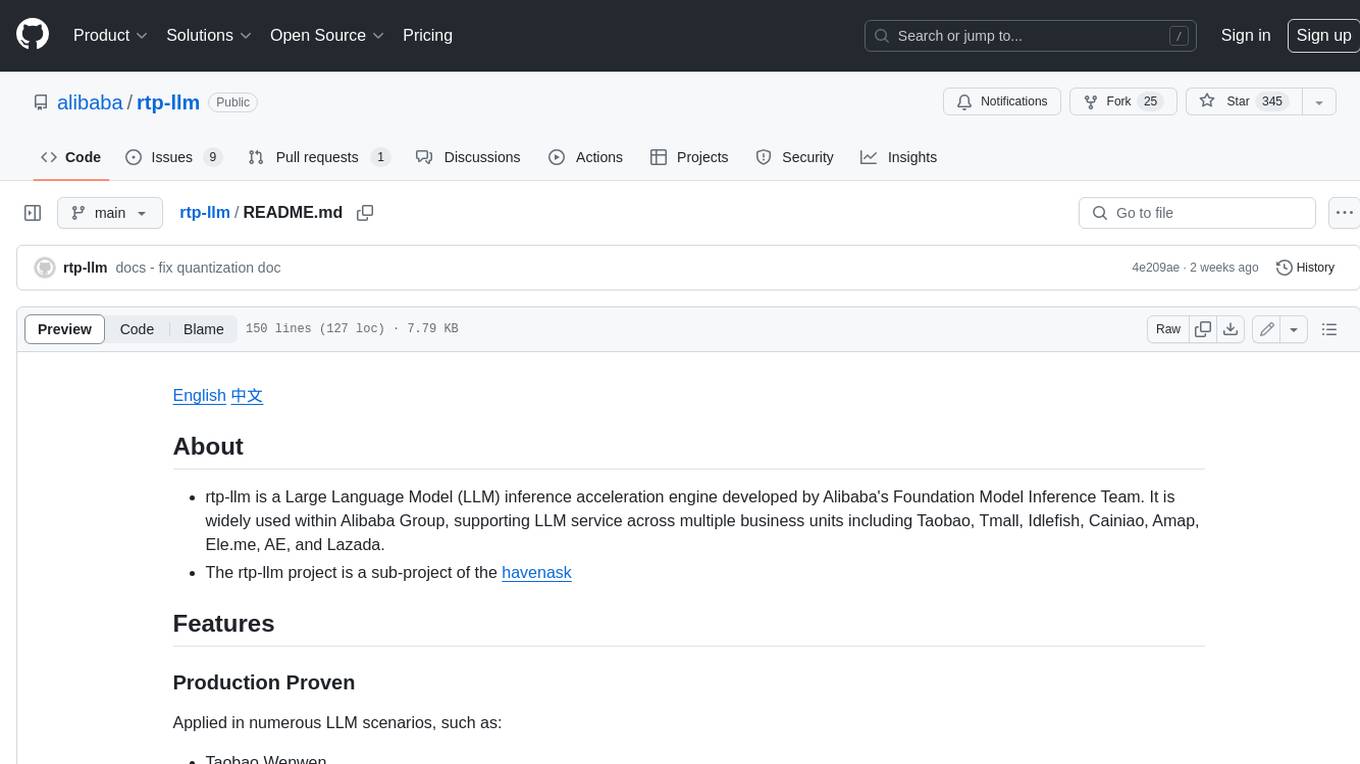
rtp-llm
**rtp-llm** is a Large Language Model (LLM) inference acceleration engine developed by Alibaba's Foundation Model Inference Team. It is widely used within Alibaba Group, supporting LLM service across multiple business units including Taobao, Tmall, Idlefish, Cainiao, Amap, Ele.me, AE, and Lazada. The rtp-llm project is a sub-project of the havenask.
For similar tasks

flashinfer
FlashInfer is a library for Language Languages Models that provides high-performance implementation of LLM GPU kernels such as FlashAttention, PageAttention and LoRA. FlashInfer focus on LLM serving and inference, and delivers state-the-art performance across diverse scenarios.
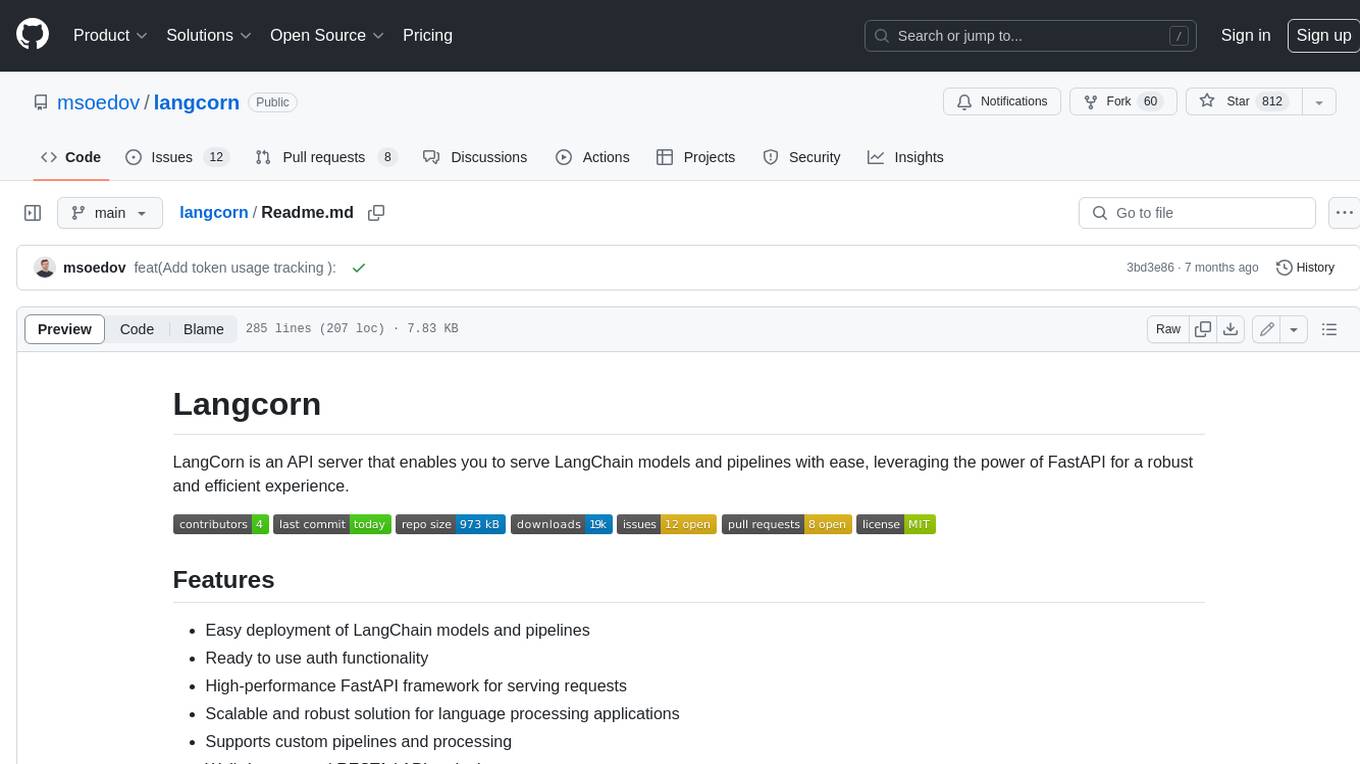
langcorn
LangCorn is an API server that enables you to serve LangChain models and pipelines with ease, leveraging the power of FastAPI for a robust and efficient experience. It offers features such as easy deployment of LangChain models and pipelines, ready-to-use authentication functionality, high-performance FastAPI framework for serving requests, scalability and robustness for language processing applications, support for custom pipelines and processing, well-documented RESTful API endpoints, and asynchronous processing for faster response times.
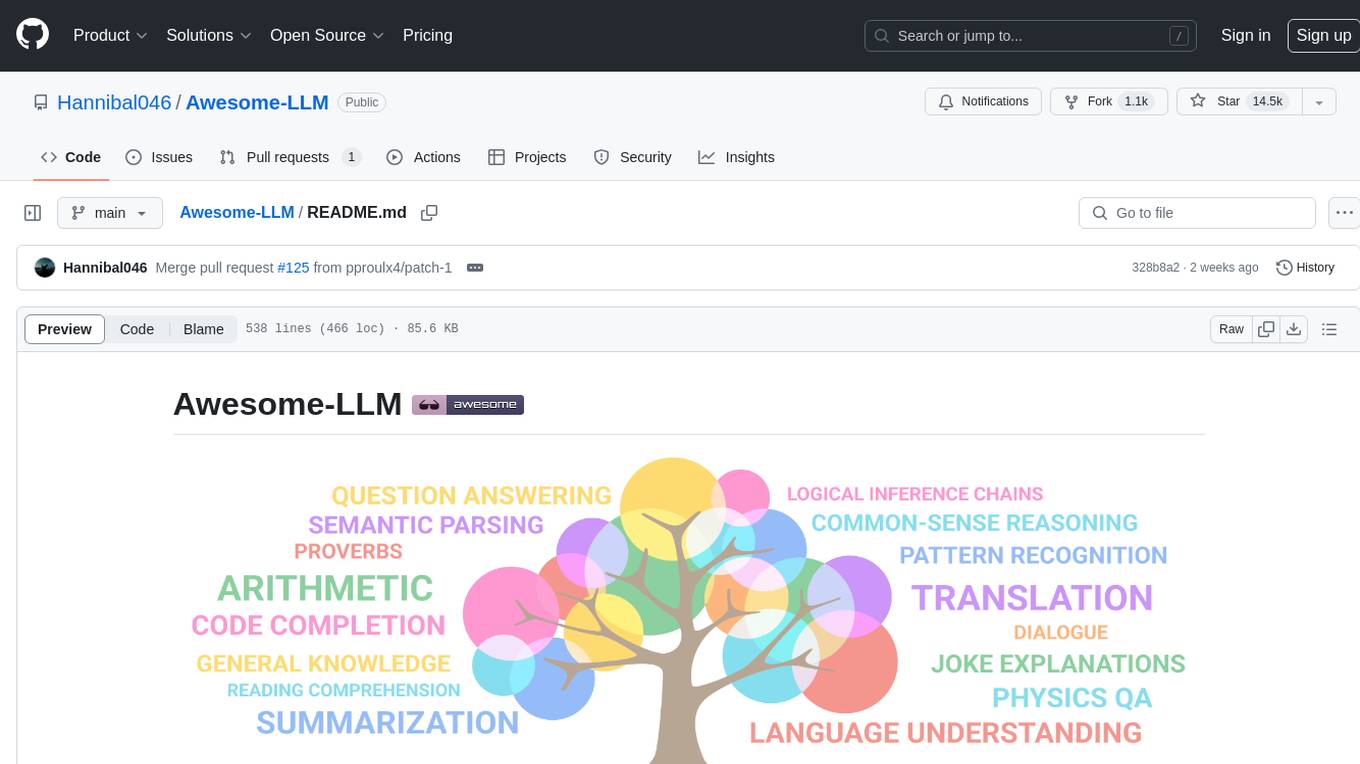
Awesome-LLM
Awesome-LLM is a curated list of resources related to large language models, focusing on papers, projects, frameworks, tools, tutorials, courses, opinions, and other useful resources in the field. It covers trending LLM projects, milestone papers, other papers, open LLM projects, LLM training frameworks, LLM evaluation frameworks, tools for deploying LLM, prompting libraries & tools, tutorials, courses, books, and opinions. The repository provides a comprehensive overview of the latest advancements and resources in the field of large language models.
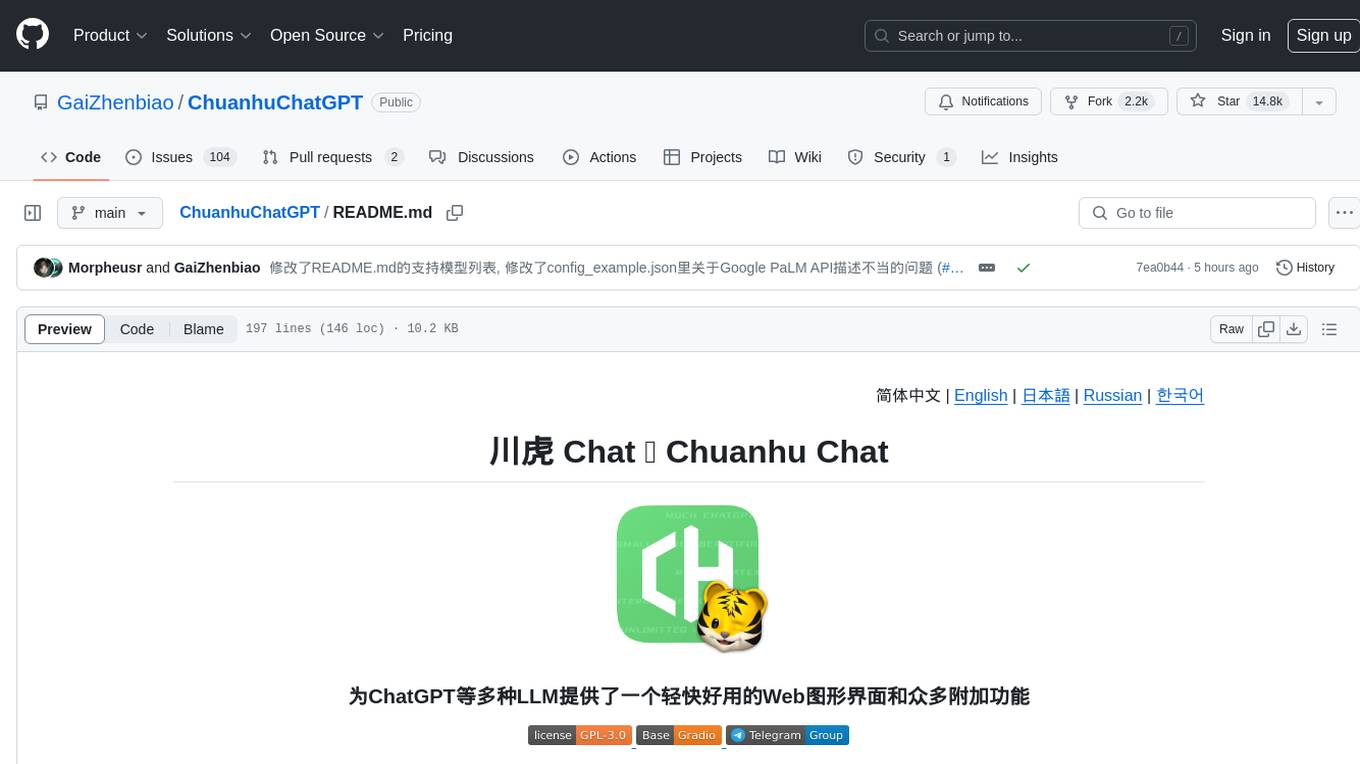
ChuanhuChatGPT
Chuanhu Chat is a user-friendly web graphical interface that provides various additional features for ChatGPT and other language models. It supports GPT-4, file-based question answering, local deployment of language models, online search, agent assistant, and fine-tuning. The tool offers a range of functionalities including auto-solving questions, online searching with network support, knowledge base for quick reading, local deployment of language models, GPT 3.5 fine-tuning, and custom model integration. It also features system prompts for effective role-playing, basic conversation capabilities with options to regenerate or delete dialogues, conversation history management with auto-saving and search functionalities, and a visually appealing user experience with themes, dark mode, LaTeX rendering, and PWA application support.
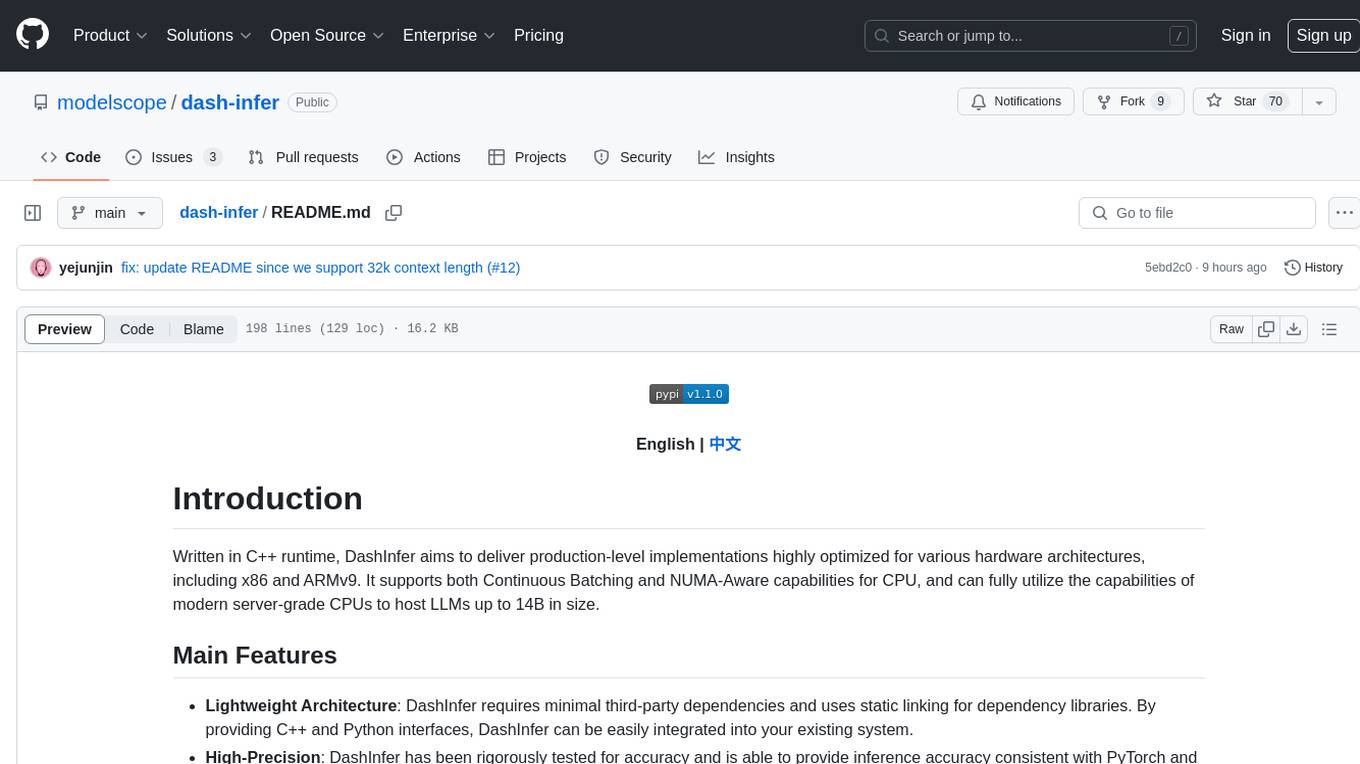
dash-infer
DashInfer is a C++ runtime tool designed to deliver production-level implementations highly optimized for various hardware architectures, including x86 and ARMv9. It supports Continuous Batching and NUMA-Aware capabilities for CPU, and can fully utilize modern server-grade CPUs to host large language models (LLMs) up to 14B in size. With lightweight architecture, high precision, support for mainstream open-source LLMs, post-training quantization, optimized computation kernels, NUMA-aware design, and multi-language API interfaces, DashInfer provides a versatile solution for efficient inference tasks. It supports x86 CPUs with AVX2 instruction set and ARMv9 CPUs with SVE instruction set, along with various data types like FP32, BF16, and InstantQuant. DashInfer also offers single-NUMA and multi-NUMA architectures for model inference, with detailed performance tests and inference accuracy evaluations available. The tool is supported on mainstream Linux server operating systems and provides documentation and examples for easy integration and usage.
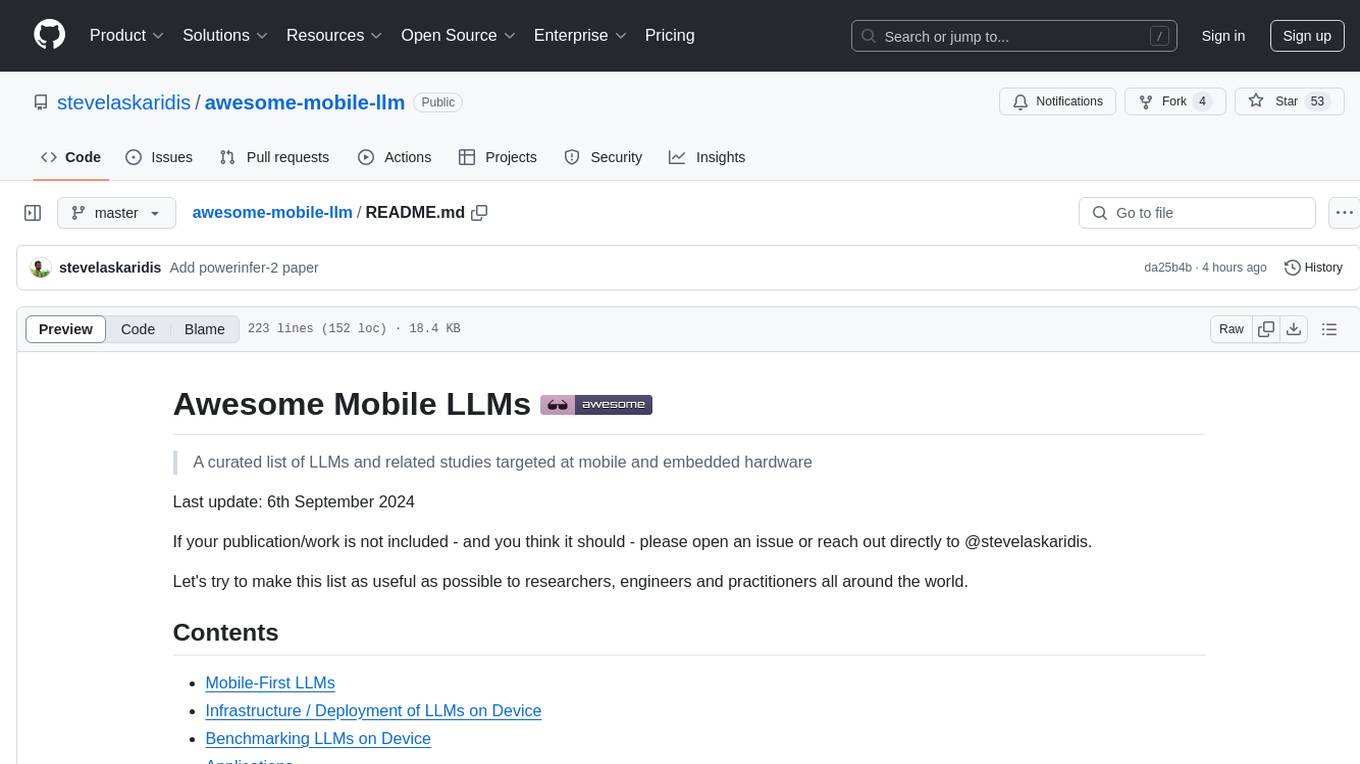
awesome-mobile-llm
Awesome Mobile LLMs is a curated list of Large Language Models (LLMs) and related studies focused on mobile and embedded hardware. The repository includes information on various LLM models, deployment frameworks, benchmarking efforts, applications, multimodal LLMs, surveys on efficient LLMs, training LLMs on device, mobile-related use-cases, industry announcements, and related repositories. It aims to be a valuable resource for researchers, engineers, and practitioners interested in mobile LLMs.
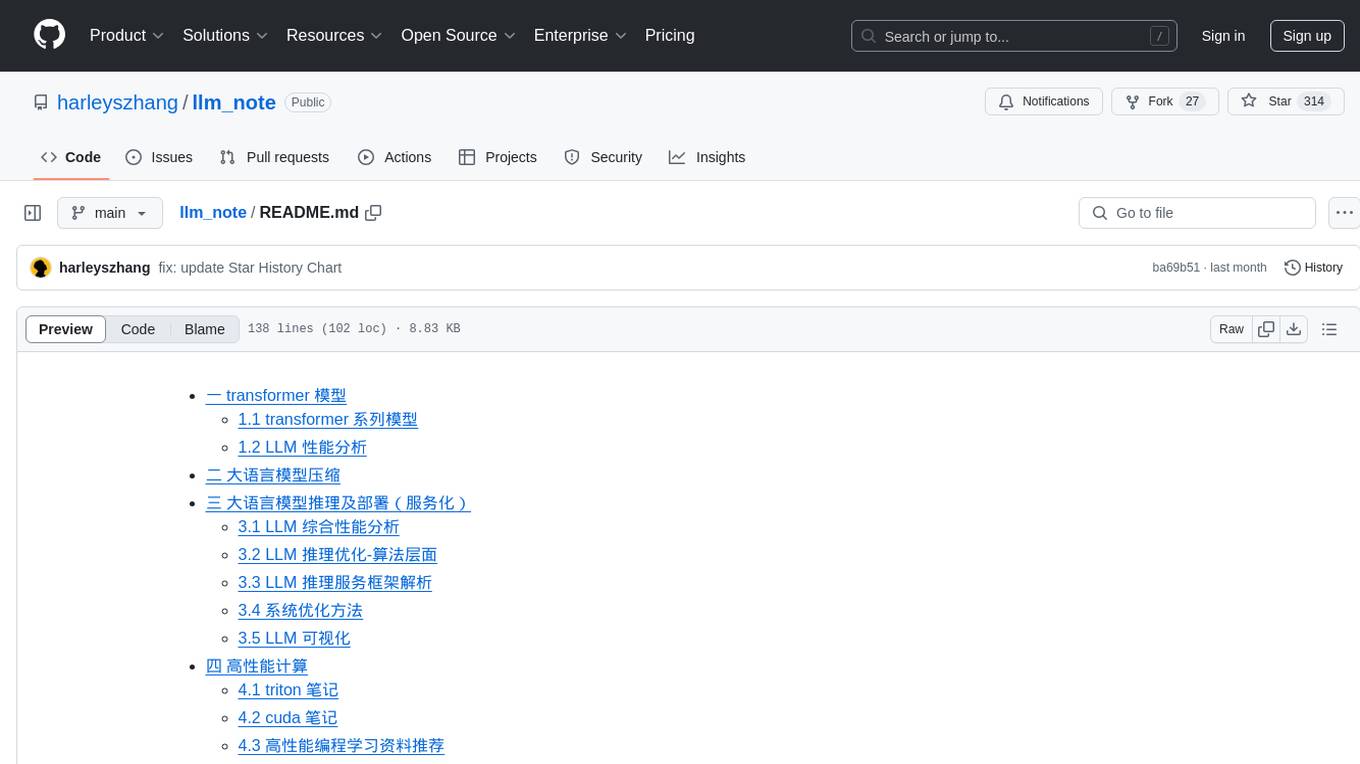
llm_note
LLM notes repository contains detailed analysis on transformer models, language model compression, inference and deployment, high-performance computing, and system optimization methods. It includes discussions on various algorithms, frameworks, and performance analysis related to large language models and high-performance computing. The repository serves as a comprehensive resource for understanding and optimizing language models and computing systems.
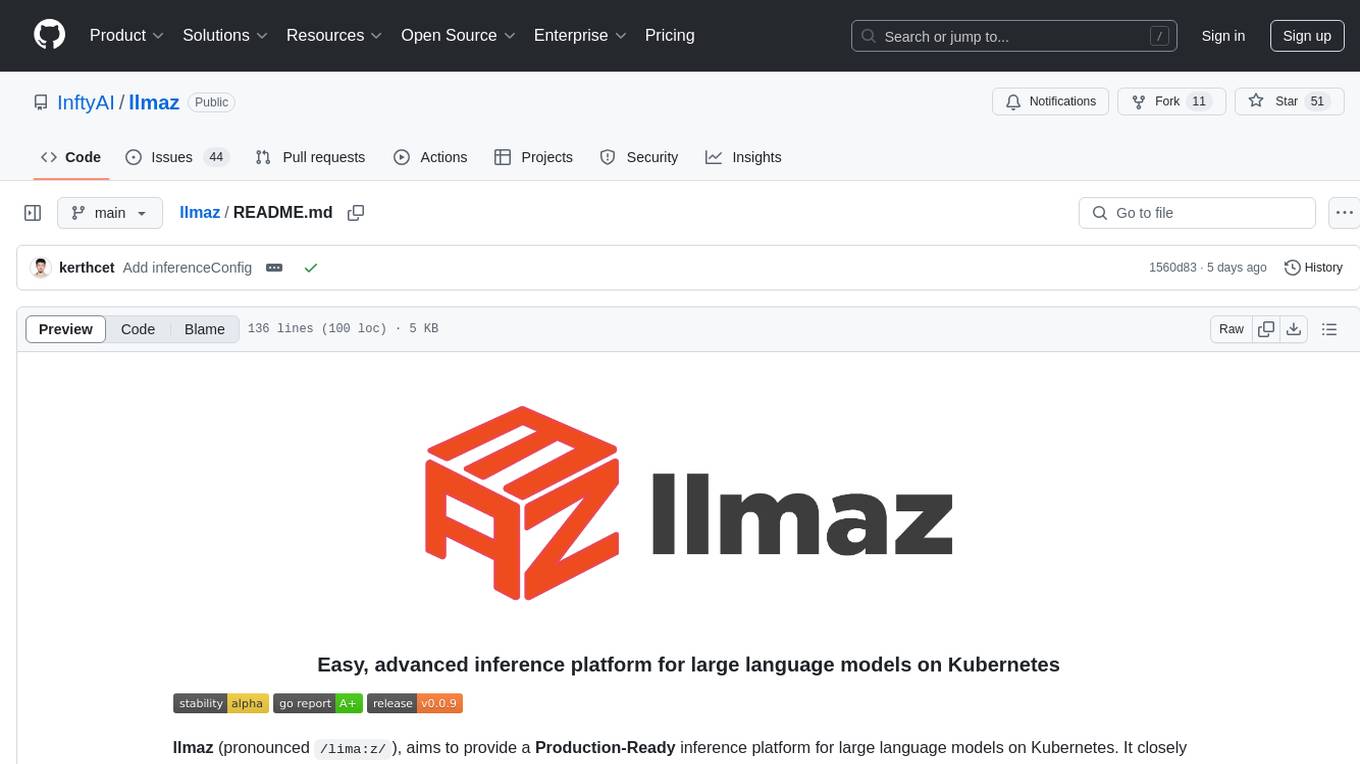
llmaz
llmaz is an easy, advanced inference platform for large language models on Kubernetes. It aims to provide a production-ready solution that integrates with state-of-the-art inference backends. The platform supports efficient model distribution, accelerator fungibility, SOTA inference, various model providers, multi-host support, and scaling efficiency. Users can quickly deploy LLM services with minimal configurations and benefit from a wide range of advanced inference backends. llmaz is designed to optimize cost and performance while supporting cutting-edge researches like Speculative Decoding or Splitwise on Kubernetes.
For similar jobs

weave
Weave is a toolkit for developing Generative AI applications, built by Weights & Biases. With Weave, you can log and debug language model inputs, outputs, and traces; build rigorous, apples-to-apples evaluations for language model use cases; and organize all the information generated across the LLM workflow, from experimentation to evaluations to production. Weave aims to bring rigor, best-practices, and composability to the inherently experimental process of developing Generative AI software, without introducing cognitive overhead.

agentcloud
AgentCloud is an open-source platform that enables companies to build and deploy private LLM chat apps, empowering teams to securely interact with their data. It comprises three main components: Agent Backend, Webapp, and Vector Proxy. To run this project locally, clone the repository, install Docker, and start the services. The project is licensed under the GNU Affero General Public License, version 3 only. Contributions and feedback are welcome from the community.

oss-fuzz-gen
This framework generates fuzz targets for real-world `C`/`C++` projects with various Large Language Models (LLM) and benchmarks them via the `OSS-Fuzz` platform. It manages to successfully leverage LLMs to generate valid fuzz targets (which generate non-zero coverage increase) for 160 C/C++ projects. The maximum line coverage increase is 29% from the existing human-written targets.

LLMStack
LLMStack is a no-code platform for building generative AI agents, workflows, and chatbots. It allows users to connect their own data, internal tools, and GPT-powered models without any coding experience. LLMStack can be deployed to the cloud or on-premise and can be accessed via HTTP API or triggered from Slack or Discord.

VisionCraft
The VisionCraft API is a free API for using over 100 different AI models. From images to sound.

kaito
Kaito is an operator that automates the AI/ML inference model deployment in a Kubernetes cluster. It manages large model files using container images, avoids tuning deployment parameters to fit GPU hardware by providing preset configurations, auto-provisions GPU nodes based on model requirements, and hosts large model images in the public Microsoft Container Registry (MCR) if the license allows. Using Kaito, the workflow of onboarding large AI inference models in Kubernetes is largely simplified.

PyRIT
PyRIT is an open access automation framework designed to empower security professionals and ML engineers to red team foundation models and their applications. It automates AI Red Teaming tasks to allow operators to focus on more complicated and time-consuming tasks and can also identify security harms such as misuse (e.g., malware generation, jailbreaking), and privacy harms (e.g., identity theft). The goal is to allow researchers to have a baseline of how well their model and entire inference pipeline is doing against different harm categories and to be able to compare that baseline to future iterations of their model. This allows them to have empirical data on how well their model is doing today, and detect any degradation of performance based on future improvements.

Azure-Analytics-and-AI-Engagement
The Azure-Analytics-and-AI-Engagement repository provides packaged Industry Scenario DREAM Demos with ARM templates (Containing a demo web application, Power BI reports, Synapse resources, AML Notebooks etc.) that can be deployed in a customer’s subscription using the CAPE tool within a matter of few hours. Partners can also deploy DREAM Demos in their own subscriptions using DPoC.
